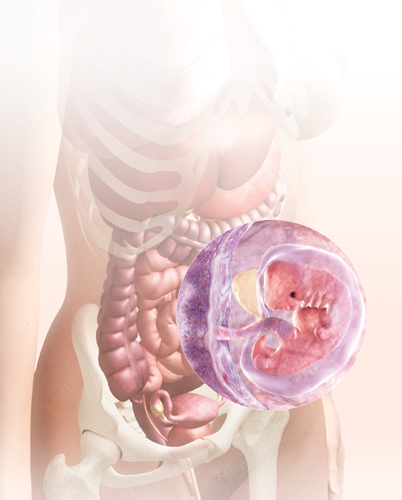You are 6 Weeks Exactly 238 days to go…
By the end of this sixth week, one of your baby’s major organs—the heart—is rapidly developing and circulating blood.
Your baby today
Here the back of the embryo can be seen lying over the yolk sac.
The opening overlying the developing brain has now closed (left side of
image) and this will be followed two days later by closure of the
opening at the base of the spine (out of view).

Your developing embryo may still be tiny, but is undergoing rapid and complex development.
The heartbeat is
now more easily recognized on an ultrasound scan. The heart continues to
form from a simple smooth tube which, as it becomes more muscular,
loops, folds, and divides to form four chambers. On the left side the
upper chamber (left atrium) takes in blood from the lungs. From here
blood passes through a one-way valve (the mitral valve) into the main
left pumping chamber (the left ventricle). This then pumps blood out of
the heart to the body along the main artery (the aorta). On the
right-hand side of the heart, the upper chamber (right atrium) collects
blood returning from the body and passes it through a one-way valve
(tricuspid valve) into the right main pumping chamber (right ventricle).
This pumps blood to the lungs and the cycle continues.
At this stage of
development, the circulation is very basic with the heart tube simply
sending blood around the length of your baby. No blood travels from your
baby’s circulation to the placenta .
Types of miscarriage
At this early stage,
a common concern is that the pregnancy will miscarry. A miscarriage is
the spontaneous loss of a pregnancy at any time up until the 20th week.
After 20 weeks the loss is referred to as a stillbirth. The signs of a
miscarriage are vaginal bleeding and periodlike cramps.
Unfortunately, there
is nothing that you can do to prevent a miscarriage. In around 60
percent of cases, it is caused by a one-time genetic problem. Bleeding
does not always mean that the pregnancy is being miscarried. Since not
all miscarriages follow the same pattern, there are various terms to
describe what happens:
A threatened miscarriage occurs when the pregnant woman experiences bleeding and possibly pain, but the baby survives.
An inevitable miscarriage
occurs when there is bleeding and pain due to the pregnant woman’s
uterus contracting. The cervix opens, and the fetus is expelled.
A missed miscarriage is when the fetus dies but is not expelled. Surgery may be needed to remove it.
Actual size of your baby
At 6 weeks, your baby’s crown to rump length is 0.15 in (4 mm).
Your 7th Week
Getting in shape now
will stand you in good stead as your pregnancy continues. Keeping active
is important, so work up a daily exercise routine to strengthen your
muscles and reduce fatigue—but listen to your body and don’t exhaust
yourself. This week your baby’s vital organs, including the lungs and
gut, start to develop. Your baby’s head already looks too big for his
body as the brain rapidly enlarges.
NOTE
Set yourself some fitness standards to see you through your pregnancy
Embryo at 7 weeks

You are 6 Weeks and 1 Day 237 days to go…
You may be spending a lot of time in front of the mirror trying to spot your “bump,” but it could be weeks yet before you show.
Your baby today
In this side view of the embryo the spinal cord is clearly
curved as it begins to develop. The pale-yellow ridgelike structures
along the back are somites—your baby’s developing muscular system.

Like most newly pregnant women,
you’re probably on the lookout for a rounded belly, but it’s unlikely
to make an appearance just yet. On average, the fourth month marks the
greatest period of growth, with your pregnancy most definitely appearing
as a rounded abdomen.
If it’s not your first
pregnancy, you might show earlier, possibly as early as eight to 10
weeks, since your abdominal muscles will be more relaxed. Conversely,
women who have firm abdominal muscles may show later. If you are
expecting twins or triplets, you can expect to show even earlier.
… Doctor
| Q: |
Can having sex in pregnancy harm the baby?
|
| A: |
Unless you have been told by your doctor to avoid sex because
of specific problems, such as a history of miscarriage or unexplained
bleeding, then sex is safe at any stage. Enjoying intimacy with your
partner is beneficial to your relationship.
Your baby is
cushioned in fluid in the amniotic sac inside your uterus and protected
by a plug of mucus at the cervix. Even deep penetration isn’t harmful.
|
Strengthen your abdominals
It’s safe to do abdominal exercises lying on your back during your first trimester. Toward the end of the first trimester, or when you start “showing” (see image), you should stop doing abdominal exercises on your back .
When you are
doing abdominal exercises, it’s important to breathe correctly: remember
to inhale to start and exhale on each effort.
The purpose of
abdominal exercises is to strengthen core muscles. The deeper transverse
abdominis muscle that runs horizontally across your body is vital for
core stability and strength as your baby develops. The rectus abdominis
muscle that runs vertically down your body is the muscle that will
stretch during pregnancy and weaken, so it’s vital to keep the
transverse muscle strong to help your posture and support your spine.
The sooner you begin
to strengthen the transverse abdominis, the better. In the first
trimester, one of the exercises you can do to strengthen this muscle is
shown below.
Lie on your back,
feet flat on the floor and arms at your sides. Inhale to begin and as
you slowly exhale, push your lower back flat on to the floor. Hold this
position for 3–5 seconds and repeat.

Strengthening and Toning Exercises
Exercises that
strengthen your muscles will help you deal with the additional demands
of pregnancy and to manage better during labor and birth.
The exercises
shown are sometimes called “functional movement enhancers” because they
increase the strength of the muscles that you use for everyday functions
such as walking, carrying, lifting, sitting, and standing. The workout
can be used alongside walking, swimming, or other cardiovascular
exercises and can be done around 2–3 times a week.
Warm up
Walk in place, swinging your arms back and forth. Continue for 3–5 minutes until your muscles are warm.
Biceps curl
The biceps is an important muscle for carrying and lifting. You
can use 3–5 lb (1–2 kg) weights for this sequence if you’re a regular
exerciser. Stand with feet hip-width apart, knees slightly bent, back
straight, and arms at your sides. Breathe in, then exhale as you bend
one elbow, raising your hand to shoulder level. Alternate arms until
you’ve done 20 curls each side (40 in total). If you find this easy, try
doing a total of 60 curls.

Side lunges
These (and the forward lunges,) strengthen the abdominal and
thigh muscles. Start with hands on hips, legs hip-width apart. Step one
leg out to the side, bending the knee. Keep the other leg straight. Step
back to the starting position, keeping the tummy pulled in and torso
straight. Do 10 lunges on each leg.

Forward lunges
Start with hands on hips, feet hip-width apart. Step one leg
forward; bend the opposite knee toward the floor, allowing the heel to
lift off the floor. Return to the starting position. Do 10 lunges on
each leg.

The bridge
This exercise works your bottom, hamstrings, and inner thighs,
and builds strength in your lower body to support your growing belly.
Lie on your back with your feet flat on the floor and knees slightly
apart. Raise your hips (this relieves pressure on your back and is safe
in the second and third trimesters). Keep your hands on the floor next
to you, arms straight. Slowly bring your knees together while clenching
your bottom; open and close your knees 10 times. Slowly lower your hips
and roll onto your left side to end.
